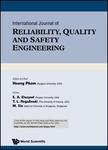版权所有:内蒙古大学图书馆 技术提供:维普资讯• 智图
内蒙古自治区呼和浩特市赛罕区大学西街235号 邮编: 010021

作者机构:Univ Massachusetts Dartmouth Dept Elect & Comp Engn N Dartmouth MA 02740 USA RMIT Univ Sch Math & Geospatial Sci Melbourne Vic 3001 Australia Naval Air Syst Command Patuxent River MD 20670 USA
出 版 物:《INTERNATIONAL JOURNAL OF RELIABILITY QUALITY AND SAFETY ENGINEERING》 (国际可靠性、质量、安全工程杂志)
年 卷 期:2017年第24卷第4期
页 面:1750020-1750020页
核心收录:
学科分类:12[管理学] 1201[管理学-管理科学与工程(可授管理学、工学学位)] 08[工学]
基 金:Naval Air Systems Command (NAVAIR) through the Systems Engineering Research Center (SERC) Department of Defense (DoD) University Affiliated Research Center (UARC)United States Department of Defense National Science Foundation (NSF)National Science Foundation (NSF)
主 题:Software reliability expectation-maximization algorithms stochastic processes non-homogeneous Poisson process statistical inference
摘 要:Non-homogeneous Poisson process (NHPP) software reliability growth models (SRGMa) enable quantitative metrics to guide decisions during the software engineering life cycle, including test resource allocation and release planning. However, many SRGM possess complex mathematical forms that make them difficult to apply. Specifically, traditional procedures solve a system of nonlinear equations to identify the numerical parameters that best characterize failure data. Recently, researchers have developed expectation-maximization (EM) algorithms for NHPP SRGM that exhibit better convergence properties and can therefore find maximum likelihood estimates with greater ease. This paper presents an adaptive EM (AEM) algorithm, which combines an earlier EM algorithm for NHPP SRGM with unconstrained search of the model parameter space. Our performance analysis shows that the AEM outperforms state-of-the-art EM algorithms for NHPP SRGM with very strong statistical significance, which is as much as hundreds of times faster on some data sets. Thus, the approach can fit SRGM very quickly. We also incorporate this high performance adaptive EM algorithm into a heuristic nested model selection procedure to objectively select a model of least complexity that best characterizes the failure data. Results indicate this heuristic approach often identifies the model possessing the best model selection criteria.